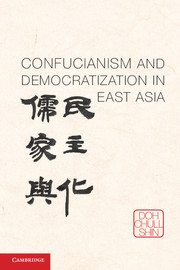Book contents
- Frontmatter
- Contents
- Acknowledgments
- Introduction
- Part i Confucianism and Confucian East Asia
- 1 The Evolution of Confucian East Asia and Its Cultural Legacies
- 2 The Confucian Asian Values Thesis
- Part ii Upholding Confucian Legacies
- Part iii Engaging in Civic Life
- Part iv Embracing Democracy
- Part v Final Thoughts
- References
- Index
1 - The Evolution of Confucian East Asia and Its Cultural Legacies
from Part i - Confucianism and Confucian East Asia
Published online by Cambridge University Press: 05 June 2012
- Frontmatter
- Contents
- Acknowledgments
- Introduction
- Part i Confucianism and Confucian East Asia
- 1 The Evolution of Confucian East Asia and Its Cultural Legacies
- 2 The Confucian Asian Values Thesis
- Part ii Upholding Confucian Legacies
- Part iii Engaging in Civic Life
- Part iv Embracing Democracy
- Part v Final Thoughts
- References
- Index
Summary
Over the past three decades, East Asia has been the most successful region of the world in expanding its economy, recovering from financial crises, and enhancing the quality of its citizens’ lives (Fukuyama 2011; Izvorski 2010; Shin and Inoguchi 2009; World Bank 2000, 2003). As a result, it has received a great deal of attention from the global scholarly community and policy circles (Dupont 1996; Hira 2007; C. Kim 2010; Miller 2006). Within the scholarly community, the region is often viewed as a model of socioeconomic and political modernization that is more harmonious, kinder, and gentler than the capitalist liberal democratic model of the West (Bell 2008a; Rozman 2002; Tu 2000). Among policy makers, East Asia is increasingly regarded as a region of powerhouses contending for global superiority (Huntington 1996; Rozman 1991b; Scher 2010).
What distinguishes East Asia from the other parts of Asia, the world's largest continent? Do the countries of East Asia share a cultural heritage or some historical experience that ties or unites them into a cohesive whole? Do they have similar patterns of organizing public and private institutions? Do their citizens exhibit any distinct patterns of thinking or action? The answers to these and other related questions depend on how the term “East Asia” is defined. Although the term has been used for centuries, there is considerable ambiguity regarding its meaning. As a result, East Asia does not always refer to the same collective among and across different professional communities and intellectual circles.
- Type
- Chapter
- Information
- Confucianism and Democratization in East Asia , pp. 21 - 52Publisher: Cambridge University PressPrint publication year: 2011



